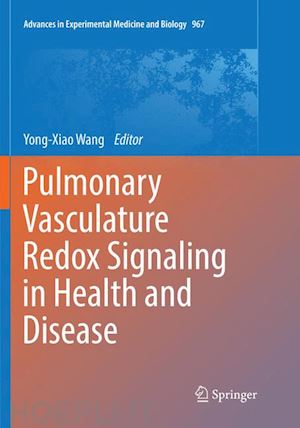
Questo prodotto usufruisce delle SPEDIZIONI GRATIS
selezionando l'opzione Corriere Veloce in fase di ordine.
Pagabile anche con Carta della cultura giovani e del merito, 18App Bonus Cultura e Carta del Docente
The main goal of this book is to form a high-quality platform in which well-known and emerging pioneering basic, translational and clinical scientists can present their latest, exciting findings in the studies of redox signaling in the pulmonary vasculature. Content from outstanding investigators with unique expertise and skills of molecular and cell biology, biochemistry, physiology, pharmacology, biophysics, biotechnology and medicine will update our current out-of-date concepts with new knowledge. Rapidly increasing scientific studies have gathered a large volume of novel and important information on redox signaling in healthy and diseased pulmonary vasculature. This volume covers the need for a cohesive book to display state-of-the-art advances in the field.
The second major aim of this book is to help direct future research. Redox signaling is a major molecular process involved in almost every physiologic cellular response in the pulmonary vasculature including energy metabolism, host defense, gene expression, contraction, proliferation, and migration. Aberrancy in this important signaling pathway leads to a critical role in the development of nearly all pulmonary diseases, such as pulmonary hypertension, cor pulmonale, pulmonary edema, and vasculitis, among others.Chapter1. Adventitial Fibroblast Nox4 Expression and ROS Signaling in Pulmonary Arterial Hypertension.- Chapter2. Role of Transcription Factors in Pulmonary Artery Smooth Muscle Cells: An important Link to Hypoxic Pulmonary Hypertension.- Chapter3. Molecular Basis of Nitrative Stress in the Pathogenesis of Pulmonary Hypertension.- Chapter4. Pentose Shunt, Glucose-6-phosphate dehydrogenase and NADPH redox, and Stem cells in Pulmonary Hypertension.- Chapter5. Redox regulation of the superoxide dismutases SOD3 and SOD2 in the pulmonary circulation. – Chapter6. A Brief Overview of Nitric Oxide and Reactive Oxygen Species Signaling In Hypoxia-Induced Pulmonary Hypertension.- Chapter7. Altered redox balance in the development of chronic hypoxia- induced pulmonary hypertension.- Chapter8. ROS signaling in the pathogenesis of acute lung injury (ALI) and acute respiratory distress syndrome (ARDS).- Chapter9. Redox-dependent calpain signaling in airway and pulmonary vascular and remodeling inCOPD.- Chapter10. Natural antioxidants as potential therapy, and a promising role for melatonin against pulmonary hypertension.- Chapter11. Effects of Hyperoxia on the Developing Airway and Pulmonary Vasculature.- Chapter12. Lung ischemia/reperfusion injury – the role of reactive oxygen species.- Chapter13. Redox Mechanisms Influencing cGMP Signaling in Pulmonary Vascular Physiology and Pathophysiology.- Chapter14. Metabolic Reprogramming and Redox Signaling in Pulmonary Hypertension.- Chapter15. Hydrogen sulfide as an O2 sensor: a critical analysis.- Chapter16. Redox Signaling and Persistent Pulmonary Hypertension of the Newborn.- Chapter17. Crosstalk between mitochondrial reactive oxygen species and sarcoplasmic reticulum calcium in pulmonary arterial smooth muscle cells.- Chapter18. Endothelial Cell Reactive Oxygen Species and Ca2+ Signaling in Pulmonary Hypertension.- Chapter19. Redox signaling in the right ventricle.- Chapter20. Hypoxia and Local Inflammation in Pulmonary ArteryStructure and Function.- Chapter21. From physiological redox signalling to oxidant stress.- Chapter22. Emerging Role of MicroRNAs and Long Noncoding RNAs in Healthy and Diseased Lung.- Chapter23. Techniques for Detecting Reactive Oxygen Species in Pulmonary Vasculature Redox Signaling.- Chapter24. Mitochondrial and metabolic drivers of pulmonary vascular endothelial dysfunction in pulmonary hypertension.- Chapter25. Subcellular Redox Signaling.- Chapter26. Reactive oxygen species in COPD-related vascular remodeling.











Il sito utilizza cookie ed altri strumenti di tracciamento che raccolgono informazioni dal dispositivo dell’utente. Oltre ai cookie tecnici ed analitici aggregati, strettamente necessari per il funzionamento di questo sito web, previo consenso dell’utente possono essere installati cookie di profilazione e marketing e cookie dei social media. Cliccando su “Accetto tutti i cookie” saranno attivate tutte le categorie di cookie. Per accettare solo deterninate categorie di cookie, cliccare invece su “Impostazioni cookie”. Chiudendo il banner o continuando a navigare saranno installati solo cookie tecnici. Per maggiori dettagli, consultare la Cookie Policy.